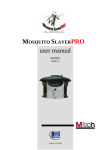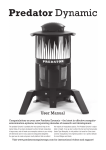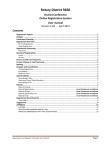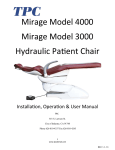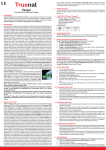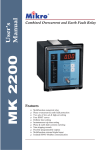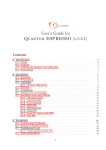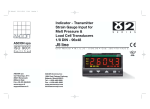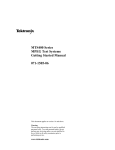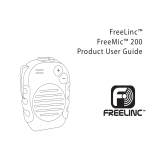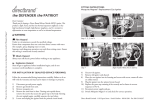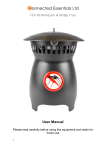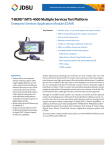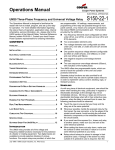Download BANTRAP - KellySolutions.com
Transcript
SEE INSIDE - MANUAL FOR DIRECTIONS FOR USE BANTRAP Mosquito Control System BA EPA EST NUMBER 089967 - AUS - 001 NTRAP Mosquito Control System TRAPPING DEVICE TO CONTROL BITING MOSQUITOES AND MIDGE Environmentally Friendly Safe and Easy to Use Product of M-Tech International Pty Ltd 39 Taree Street Burleigh Heads 4220 QLD, Australia T: +61 7 5593 5188 F: +61 7 5593 5587 www.bantix.com.au Net Contents: Mosquito Trap Instruction Manual Electrical Cord and Powerpack Net Weight: 7.50 lbs COLOURS OF TRAP MAY VARY The Bantrap Series 4 mosquito trap Known as the Mosquito Slayer series 4 in Australia User manual Model MTS4 CO2 gas Model MTS4 Non gas EPA Est number 089967-AUS-001 1 of 14 Edition 3 4-9-2013 Read This First Please read the instructions in this manual carefully. They are intended to help you install and operate your Mosquito Trap safely and effectively. Information in this document is subject to change without notice. The gas used is CO2 (carbon dioxide the same gas used in soft drinks) it is not Propane Intended use The Mosquito Trap is designed to impact the breeding cycle and to reduce the local populations of a variety of mosquitoes and midges. The Supplier does not claim that use of this product will result in complete removal of mosquitoes or biting midge from a location. Factors including best placement of the trap, regular maintenance, upkeep of lures and prevailing environmental conditions will affect results. Designed for outdoor use. Copyright Copyrighted © 2008 by the Supplier. All rights reserved. No part of this document may be reproduced or transmitted in any form or by any means, electronic or mechanical, for any purpose, without the express permission of The Supplier. Patent The Mosquito Trap technology has protection under US Patent No. 6,199,316 and other patents pending. Known as the Mosquito - Slayer series 4 gas and non-gas models in Australia and 78 other countries throughout the world. Only use EPA-registered lures. Read and follow all labels directions on any EPA-registered lure used. Head Office 39 Taree Street Queensland, Australia, 4220 T: 61755935188 www.bantix.com.au USA Distributor Phone Email Web Fax of 16 22 of 14 Table of Contents Safety First 4 Specification Sheet 5 How the Mosquito Trap Works 6 Gas Regulator Hose / Modulator fitting 7 CO2 Modulator Fact Sheet 8 Placement Guidelines 9 Installing the Trap 10 Installing a Trap Barrier 11 Maintenance & Servicing Troubleshooting 12a 12b Risk Assessment 13 Warranty More information on gas and hose fitting 14a 14b of 16 33 of 14 Safety First CAUTION: Keep out of reach of children. CAUTION: Keep pets away from the unit. CAUTION: Do not put fingers or hands inside the machine when it is operating. WARNING: Avoid direct eye contact with UV light. Prolonged exposure may cause eye injury. CAUTION: To prevent fire or shock hazard, do not hose the unit or immerse in water. CAUTION: The trap uses 12 V AC or DC power and comes with an approved transformer. Do not use unapproved transformers. CAUTION: To avoid malfunction, do not position the trap in range of automatic sprinklers. WARNING: To avoid the trap becoming a breeding site for mosquitoes, do not allow water to accumulate in the tray when the trap is not operating. If the trap is not going and you leave it mounted outdoors, pull the tray out. NOTE: The Risk Assessment included in this document shows that this equipment is safe when installed and operated in accordance with the manufacturer’s guidelines. of 16 44 of 14 MODEL NUMBER VARIANTS Specification Sheet MTS4 1. STANDARD UNIT 2. SATELLITE UNIT 3. GAS UNIT* PRODUCT DETAIL Heat On-board heater Moisture From solution in the tray Ultraviolet Light LEDs x 4 Spectrum Light Pulsed light at varying wavelengths Coloured Light Randomly pulsed select colours of light Movement Pattern of light action provides illusion of host movement Sound Mimics a feeding female mosquito Dark Colour Black and white casing Contrast Colour White tray provides contrast to black and white and makes for easier sighting of captured mosquitoes and midge Power Requirement 12V AC/DC 50-60Hz Can run off solar and battery power 1Amp Average Running Power 12W Consumption Standard Transformer 220-240 VAC to 120V AC 3 Amp transformer is also available 12VAC/DC, 5 Amp, 50-60Hz Trap Dimensions 30cm x 22cm x 21 cm Trap Weight 1.3 kg Weight of ‘Standard’ Unit Shipping Pack Weight of ‘Satellite’ Shipping Pack Shipping Carton Dimensions System Configurations 4.6 kg *Carbon Dioxide Lactic Acid Octenol Minus the transformer etc 3.75 kg 44cm x 23 cm x 23cm 220-240 VAC to 12VAC/DC, 5 Amp, 50-60Hz For both the Standard and Satellite A Standard and up to two Satellite* units can be linked to form multiple-unit barriers. More units can be linked when powered by high output solar panels or larger transformers Please note: The Series 4 non-gas Trap can easily be upgraded to a carbon dioxide trap by purchasing a gas regulator hose which controls gas flow directly from a CO2 cylinder. The gas can be dispensed to air or the hose can also feed through a CO2 Modulator to produce pulsing of the gas The CO2 Cylinder is not provided with trap. Approved Lactic acid and Octanol lures can be purchased from some retail outlets Any EPA-registered products can be used. Ask for details Any EPA-registered product can be used. Ask for details. 16 55ofof14 How the Mosquito Trap Works Series 4 Power in AC or DC (socket at each end) 8 9 1 7 3 5 10 4 8 11 1 Gas Regulator Hose CO2 Modulator 2 Tray holds 2L of water. Add lure to water Circulating air pushes the mosquitoes into tray to drown 9 6 Attractant Description Built-in Attractors: 1. Heat: Mosquitoes are drawn to the body heat of humans. A heating element in the trap produces a controlled radiating warm surface that closely mimics typical body temperature. 2. Moisture: The trap produces a moist, warm air stream that simulates human perspiration. Moisture is provided by evaporation induced by the fan-circulated warm air passing over the water in the collection tray. 3. Spectrum Light: Random frequencies of pulsed light are refracted through a prismatic disperser to provide a wide spectrum of attractive light wavelengths to cater to the selective nature of some mosquito species. 4. Ultraviolet Light (UV): UV light attracts certain species particularly night feeders. The Trap is fitted with 4 pulsing UV LEDs. 5. Sound: Mosquitoes are attracted to a certain varying sound frequency. 6. Movement: Mosquitoes are attracted to the movement of potential hosts. The pulsing of varying coloured light frequencies through the spectrum prism gives the illusion of movement to a female mosquito. 7. Color: Mosquitoes are drawn to dark colors. The dark casing with the white tray of the trap helps mosquito in-flight orientation toward a host. 8. Supplemental Lures: Various attractants and attractant blends can be used to supplement the built-in attractors such as: 9 Carbon Dioxide (CO2): Mosquitoes can detect the CO2 from the breath of a mammal from up to 30 meters away. Female mosquitoes use CO2 to orient themselves towards a suitable host to feed on. CO2 is a primary attractant to most species of mosquitoes. It can be plumed to open air as continuous flow or pulsed through the CO2 Modulator. 10 Lactic Acid: Released naturally through human perspiration and animal sweat. EPA-registered lures can be used separately or in lure blends – in the tray. 11 Octenol: is attractive to many species of mosquitoes especially when combined with CO 2. Octenol is a naturally occurring by-product that comes from animals that ingest large amounts of vegetable matter, such as cattle. EPA-registered octenol in cartridge form can be fitted. 12 The CO2 Modulator device pulses the carbon dioxide dispensed from a cylinder and emits a plume of CO2 13 Read and follow all Label instructions for EPA-registered lures of 16 66 of 14 Gas Regulator Hose / Modulator fitting The modulators are disposable and environmentally friendly. The gas hose fits onto bottle and then pushes into trumpet feeder below The trumpet feeder above clips into the modulator below once red cap below is removed from the modulator The red cap above unscrews from the modulator below which has food grade safe liquid attractant inside of it and the trumpet connected to the hose clips into the modulator below, you throw away the modulator and trumpet after 30 days use. Modulator 14 7 of 16 Co2 Modulator Fact Sheet For the Mosquito Trap Series 4 A CO2 Modulator can be used when the Mosquito Trap Series 4 is fitted with a proprietary Gas Regulator Hose to dispense carbon dioxide direct from a CO2 cylinder. The CO2 Modulator (See Fig. 3 & 4) changes the continuous flow of CO2 coming through the Gas Regulator Hose into intermittent plumes. This pulsing of the CO2 more closely mimics the breathing pattern of mammals and has been shown to increase catch rates of host-seeking female mosquitoes. All standard Mosquito Trap Series 4 units are made with the holes to accommodate the clips to fit a CO2 Modulator (See Fig. 2). However, the two plastic clips are not provided in the standard non gas Series 4 trap. If you want to upgrade a non-gas series 4 Trap you presently have into a gas/modulator trap the clips, CO2 Modulator and Gas Regulator Hose have to be ordered separately, as a kit. The Mosquito Trap Series 4 gas will come with a CO2 Modulator two mounting clips and a Gas Regulator Hose and Nylon washer. The clips will need to be inserted as per Fig. 1. The CO2 Modulator is a consumable and should be replaced every 30 days (it is made from environmentally friendly recyclable plastic). Fig. 1 Clips x 2 Fig. 3 Fig. 2 CO2 Modulator Fig. 4 Clip is pushed into hole Gas Regulator Hose connected to the CO2 Modulator 1-080908 88ofof14 16 Placement Guidelines Position the trap away from where people gather in order to draw the mosquitoes away, do not put it close to your pool or verandah where people are sitting as the female will always land to feed on the largest landing area which is you. Place at least 5 to 10 meters away (15 to 30 feet). If possible, place the trap near where the mosquitoes are breeding (wetlands, creeks, standing water etc). Locate the trap near to where mosquitoes rest (trees, shrubs, tall grass, culverts and under highset houses). Locate the trap to intercept the mosquitoes before they move to human gathering places. In other words, the trap should act as a barrier between the breeding or resting area and where people gather. Face the trap towards the mosquito breeding and resting areas. Don’t place the trap in wide open cleared areas in full sun. The direction of prevailing winds should be considered when choosing a site as mosquitoes sense their prey from downwind and fly upwind to a host, always try to place the trap in an area shielded from the wind. Don’t face the trap into the hot afternoon sun. Keep the trap out of reach of children. Generally mount the trap at waist to head high. When using carbon dioxide gas please note that the gas is heavier than air, therefore the gas will fall and drift downhill. Try to locate the trap on high ground, if placing it on an undulating site. It is best to place the gas cylinder in the shade or covered and where it will not be knocked or tripped over. Secure it safely so it won't topple. Follow safety instructions provided on the gas cylinder. The standard gas regulator hose is 1.5m in length. The position of an external power point (sometimes located in the home meter box) will influence where you place the trap. The electrical cord from the power point to the outdoor transformer is 6 feet (2m). The standard electrical cord from the transformer to the unit is 15 feet (5m) (longer lengths are available). The trap can be mounted to a wall, fence or other suitable structure. Ask your distributor about trolleys. Do not place the trap in range of automatic sprinklers, do not fill tray by squirting a hose into the trap. (it is water resistant for outdoor use not flood proof) 99 of of16 14 Installing the Trap Procedure 1. Mount the trap horizontally to a suitable vertical surface such as a fence, wall or post. Take the weight of the unit (approx. 4 kg full) into consideration when deciding on the mounting surface and also when selecting the proper fasteners. 2. Fix two 5mm screws with 8mm heads to a suitable mounting surface leaving the screws extended approximately 5mm. See Figure 9 for spacing. 3. Hang the trap using the two key holes to mount to the two screws. See Figure 10. Note: Screws are not provided. Connecting power 4. Find a suitable out-of-the-way position for the allweather transformer. It can be mounted to a wall or other structure to keep it out of reach of children. 5. Plug the transformer into the power point. 6. Plug the electrical cord into the transformer. The electrical cord is all-weather, low voltage. 7. Plug the other end of the electrical cord into the trap power socket. See Figure 11. Note: The electrical cord should be placed out of the way so it won’t be tripped over, pulled or run over by a lawn mower. Connecting the gas 8. Connect the gas regulator hose brass nut to the gas cylinder and tighten (fit nylon washer between nut and bottle). See Figure 12. 9. Attach the hose end to a Modulator as shown on page 8. Note: The gas regulator hose via the modulator dispenses pulsed CO2 continuously 24/7. CAUTION: When disconnecting the hose from the bottle, turn off the bottle valve first, and take care not lose the nylon washer. 168mm Centres Figure 9 Figure 10 There is a power socket at both ends. Use either one. clock model trap shown here. Figure 11 Figure 12 10 10 of of16 14 Installing a Trap Barrier Generally, up to three Mosquito traps can be linked to form a trapping barrier (using a maximum ten meter cable between the traps). The gas trap provides the CO2 into the area as CO2 is able to attract mosquitoes from up to 300 meters. Two Satellite units can be linked to the gas trap. The base trap sources its power from the transformer and provides 12 volt power to the closest Satellite unit via a standard10 meter waterproof electrical cord. This Satellite unit in turn provides power to the next Satellite unit via another electrical cord. It is important to note that the control trap does not feed carbon dioxide to the Satellite units, only the power as the CO2 dispensed from the gas trap is attracting the female mosquito into the area and they will be attracted to the satellite traps as well as the gas trap. As seen below you can also use 3 gas traps with individual bottles and powered by the one transformer. Below are different combinations, (where a manifold is required they are supplied on order from your dealer) Power only Satellite Gas unit Power only Gas Cylinder and power supplied to first satelite Satellite Gas Cylinder A Gas Manifold can disperse low pressure gas from a larger gas cylinder to multiple gas traps Only available on special request Only available on special request ONLY 11 11 of of16 14 Maintenance & Servicing After installation, the Mosquito Trap Series 4 will require maintenance at regular intervals to ensure maximum catch performance. Use the following checklist: 1. Check that the tray still has water and lure. Top up or clean the tray out and add more water and lure. In hot weather the tray may need topping up or cleaned and replenished several times a week. 2. Check the catch in the tray. If a large catch dispose of contents, clean and refill with water and lure. 3. If using a CO2 Modulator, replace every 30 days if using lactic lure add each time you fill the tray. 4. Check gas is operational and replace gas cylinder, if needed. To determine if the cylinder still contains gas, remove the outlet of the gas hose from the CO2 Modulator (Page 7) or from clip and place hose tip in a container of water to observe bubbling of CO2. If bubbling, the system is working and the bottle still contains gas. If there are no bubbles replace the gas bottle, you can also just crack open the gas hose to the bottle slightly and you will hear the gas, if you do not then your bottle needs replacing, 3 kilos last just over 1 month. Troubleshooting To determine if the trap has power 1. Are the lights functioning? 2. If not, check to ensure the transformer is plugged into the power point and switched on. 3. Ensure the transformer-to-trap electrical lead is properly plugged into both the transformer and the trap. 4. If the problem persists, call your distributor or installer. What should you do if the trap is not catching or is catching too few mosquitoes and biting midge? 1. If the trap has power, but there is no catch, check whether the fan is operating. While the trap is switched on place your hand a short way carefully into the trap mouth (Page 6). You will feel circulating air. 2. Review the placement guidelines to confirm that the trap is in the best position. 3. Sometimes moving the trap a few meters will change results. 4. Depending on the species how high the trap is off the ground could influence results (e.g. Aedes aegypti often come in low to attack a host) 5. Are you using CO2? Is the bottle empty? Put the gas regulator hose outlet end (separate it from the CO2 Modulator) into a container of water to observe bubbling. No bubbles, no gas! Note: CO2 is a primary attractant to mosquitoes and biting midge and can have a big influence on catch rates. CO2 also enhances the attractiveness of attractants such as lactic acid. 6. Do the other supplied lures need refreshing or exchanging? If you are using a CO2 Modulator it should be exchanged approx. every 30 days, if using lactic acid top up each time you fill the water tray. 7. Remember that prevailing conditions such as wind speed, humidity, moon phases etc will influence catches. High winds or lots of rain will decrease catch rates. A good minimum testing period is an entire moon phase (30+ days). A breeding cycle is 4 to 7 weeks, after this cycle you should have a noticeable reduction in mosquito numbers. 8. Use two indicators to determine outcome: 8.1 Are you regularly catching mosquitoes and/or biting midge each night or day? Please note that catch rates will vary quite considerably due to environmental conditions so don’t expect to catch the same number each night. 8.2 Is the bite pressure diminishing? In other words are your being bitten less as time goes on? 12 12 of of16 14 Risk Assessment Mosquito Trap Series 4 Product Name Product Code MOSQUITO TRAP SERIES 4 MTS4 The following Risk Assessment identifies possible Hazards that may be incurred in the installation and operation of the Mosquito Trap - Series 4. To reduce the likelihood of any Hazards occurring and to ensure that the Mosquito Trap - Series 4 is installed in accordance with the manufacturers specifications, the User Manual must be read before installing this product. Risk Assessment Calculation Risk Likelihood Risk Severity Significant Personal Injury Low Low No Eye Injury Low Low No Personal Injury Low Low No Personal Injury Low High YES Personal Injury Low Medium YES Hazard Possible Consequences Lifting – incorrect lifting procedure UV Light – staring into UV light Cuts/Abrasion - placing hand up inside operating trap. Electrocution – incorrect/faulty power cords or moisture ingress. Trip – unsecured power leads. RISK ASSESSMENT CHART LOW LIKELIHOOD MEDIUM HIGH Not Significant Not Significant Significant MEDIUM Open for Discussion Significant Significant HIGH Significant Significant Significant SEVERITY LOW 1-011008 13 13 of of16 14 Warranty The Mosquito Trap Series 4 is guaranteed against defects in materials and/or workmanship under normal conditions of use for 12 months from the date of purchase or the date the trap was commissioned under a service contract. If any part of this product, excepting consumables, becomes defective within the warranty period, The Supplier will replace the unit or, at its discretion, repair or replace the defective part or parts. Except as otherwise provided by law, this guarantee becomes invalid if, in the opinion of the Company the product has been misused, abused, damaged in transit, incorrectly installed, incorrectly maintained or connected to an electrical supply not corresponding with the product specification. Please note this warranty is limited to and conditional upon: The defective parts or unit being securely packed in a carton for return to The Supplier or its approved agent. The owner/user of the unit assuming the cost of returning the unit or any part claimed to be defective. Note: Please retain your receipt or invoice with serial number noted to show proof of purchase or commencement of service contract in the event that you need to make a claim on the warranty. More Information Further information on the Mosquito Trap can be found by contacting your local installer or distributor. User Manual Addendum Installing the Filter Washer to Gas Bottle (VERY IMPORTANT!!) Before the CO2 Gas is connected make sure that the white circular washer (white) which comes with the gas hose is installed into the outlet of the gas bottle. (see Diagram 1 below). The washer will only fit into the gas bottle one way. Once the washer is in place, install the gas hose (figure 2) and tighten gas hose nut with spanner (figure 3). When the hose is connected and tightened place the other end firmly into the modulator insert and clip the plastic clip onto the hose to keep it in place. (Diagram 1) (Diagram 2) 14 14 of of16 14 (Diagram 3) This page left intentionally blank




















